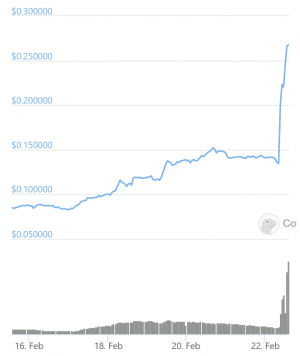The price of CRO, the native token of Crypto.com Chain, doubled in a few hours as Crypto.com said it will burn CRO 70bn as they’re preparing for the CRO Chain Mainnet launch on March 25.
At the time of writing (11:50 UTC), CRO trades at USD 0.267 and is up by 89% in a day and 207% in a week.
CRO price chart:

The major cryptoasset-powered debit card, trading, and lending services firm said that CRO 59.6bn (USD 16bn) will be burned today.
“10.4 billion is currently locked in a smart contract and will be burned monthly, as it gets unlocked. This will increase the circulating supply of CRO from current 24% to over 80%,” they added.
According to them, out of the remaining CRO 5.9bn, CRO 5bn will be allocated to mainnet block rewards for Chain validators and delegators which helps secure the network, and 0.9 billion CRO will be allocated to Particle B for Chain ecosystem development.
Particle B is a startup accelerator dedicated to incubating projects built on blockchains, including Bitcoin (BTC), Ethereum (ETH), and the Crypto.com Chain.
“We’ve long believed that the world needs a fully decentralized, open-source, public chain with high speed and low fees. Use cases driving mass crypto adoption through payments, DeFi and NFTs all need this critically important infrastructure,” the company said.
In a separate blog post, the company said that the mainnet will be launched as the Crypto.org Chain with CRO as its native currency.
According to them, Crypto.org Chain is a public, open-source and permissionless blockchain – a decentralized network designed to be a public good that helps drive mass adoption of blockchain technology
“Millions of individual users may also contribute to network security via Delegated Proof of Stake model by simply using our DeFi Wallet,” the company added.
__
What is a token burn?
A token burn is a concept unique to cryptocurrencies. By burning a certain number of tokens in circulation, token burn initiators expect to increase the value of remaining coins. It adheres to the simple supply and demand principle – if the number of coins goes down and the need for them remains the same or grows, it should (but it’s not 100% guaranteed) experience gains in price. The most common way to burn coins is to send them to a so-called burner address – a public on-chain wallet whose private keys are verifiably invalid and unobtainable.
___
Learn more:
Regulatory Kaleidoscope Challenges Crypto Industry – Crypto.com CCO
Crypto.com Rolls Back ‘Illegitimate Trades’ After System Maintenance
Crypto.com Aims for Its First Profitable Year Despite Asian Setback
__
(Updated at 12:04 PM UTC with a description of Particle B. Updated at 12:18 PM UTC with more details about the mainnet launch.)
Credit: Source link






















